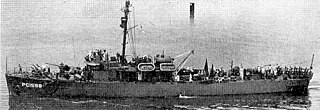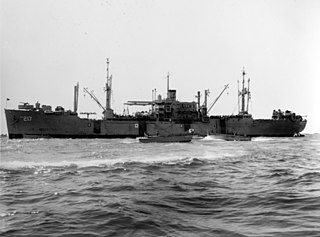
USS Mustin (DD-413) was a Sims-class destroyer of the United States Navy, the first Navy ship of that name, in honor of Captain Henry C. Mustin (1874–1923), a pioneer of naval aviation.

USS Acree (DE-167) was a Cannon-class destroyer escort in service the United States Navy from 1943 to 1946. She was scrapped in 1973.

The third USS Macdonough (DD-351) was a Farragut-class destroyer in the United States Navy during World War II. She was named for Thomas Macdonough.

USS Raby (DE/DEC-698) was a Buckley-class destroyer escort for the United States Navy. She was named for Rear Admiral James Joseph Raby (1874–1934).
USS PC-1136 was a PC-461-class submarine chaser built for the United States Navy during World War II. Shortly after the end of the war, she was renamed USS PCC-1136 when she was reclassified as a combat communications control ship. In 1956, she was renamed Galena (PC-1136), becoming the third U.S. Navy vessel so named, but never saw active service under that name.

USS Darby (DE-218) was a Buckley-class destroyer escort in service with the United States Navy from 1943 to 1947 and from 1950 to 1968. She was sunk as a target in 1970.
USS Skylark (AM-63) was an Auk-class minesweeper built for the United States Navy during World War II. She earned three battle stars during World War II. Skylark was mined and sunk off Okinawa in April 1945. She was struck from the Naval Vessel Register the same day.

USS Excel (AM-94) was an Adroit-class minesweeper of the United States Navy. Laid down on 19 December 1941 by the Jakobson Shipyard, Inc., Oyster Bay, Long Island, New York, launched on 10 May 1942, and commissioned on 11 December 1942. The ship was reclassified as a submarine chaser, PC-1598 on 1 June 1944.

The second USS Fleming (DE-32), and first ship of the name to enter service, was an Evarts-class destroyer escort built for the United States Navy during World War II. While performing convoy and escort duty in the Pacific Ocean she was also able to sink one Japanese submarine and to shoot down several kamikaze planes that intended to crash onto her. For her military prowess under battle conditions, she was awarded four battle stars.

USS Burden R. Hastings (DE-19) was an Evarts-class destroyer escort of the United States Navy during World War II. Immediately after being built, she was crewed and sent to the Pacific Ocean to escort convoys and to protect them from air and submarine attack. During her wartime service, she was credited with having sunk one Japanese submarine and otherwise protecting numerous ships from danger. She was awarded four battle stars for her services in battle areas.

USS LeHardy (DE-20) was an Evarts-class destroyer escort constructed for the United States Navy during World War II. It was promptly sent off into the Pacific Ocean to protect convoys and other ships from Japanese submarines and fighter aircraft. At the end of the war, she had the honor of proceeding to Wake Island, as the Japanese commander surrendered, and raising a flagpole to fly the American flag once again.

USS Wintle (DE-25) was an Evarts-class destroyer escort constructed for the United States Navy during World War II. The ship was promptly sent off into the Pacific Ocean to protect convoys and other ships from Japanese submarines and fighter aircraft. By the time she returned to the United States at the end of the war she had been awarded three battle stars.
The second USS Dempsey (DE-26) was an Evarts-class destroyer escort constructed for the United States Navy during World War II. She was promptly sent off into the Pacific Ocean to protect convoys and other ships from Japanese submarines and fighter aircraft. By the end of the ship's World War II service career, when she returned to the United States, she had accumulated three battle stars.

USS Dionne (DE-261) was an Evarts-class destroyer escort of the United States Navy during World War II. She was sent off into the Pacific Ocean to protect convoys and other ships from Japanese submarines and fighter aircraft. She performed escort and antisubmarine operations in dangerous battle areas and returned home with six battle stars, a high number for a ship of her type.

USS Cloues (DE-265) was an Evarts-class destroyer escort of the United States Navy during World War II. She was sent off into the Pacific Ocean to protect convoys and other ships from Japanese submarines and fighter aircraft. She performed escort and antisubmarine operations in dangerous battle areas and returned home with three battle stars.

USS Bangust was a Cannon-class destroyer escort in service with the United States Navy from 1943 to 1946. In 1952, she was sold to Peru, where she served as BAP Castilla (D-61). She was decommissioned and scrapped in 1979.
USS Change (AM-159) was an Admirable-class minesweeper built for the U.S. Navy during World War II. She was built to clear minefields in offshore waters, and served the Navy in the Pacific Ocean.

USS New Kent (APA-217) was a Haskell-class attack transport in service with the United States Navy from 1944 to 1949 and from 1951 to 1954. She was scrapped in 1972.

USS Corbesier (DE-438) was a John C. Butler-class destroyer escort in service with the United States Navy from 1944 to 1946. She was scrapped in 1973.

USS McCoy Reynolds (DE-440) was a John C. Butler-class destroyer escort acquired by the U.S. Navy during World War II. The primary purpose of the destroyer escort was to escort and protect ships in convoy, in addition to other tasks as assigned, such as patrol or radar picket. Post-war, after operating in the Pacific Ocean battle areas, her crew members returned home with four battle stars to their credit for World War II and one for the Korean War.
















